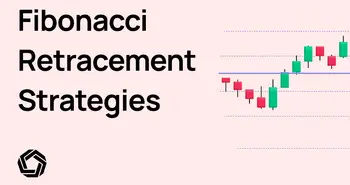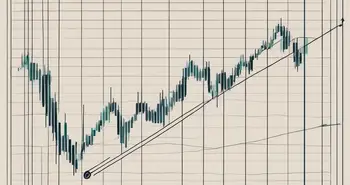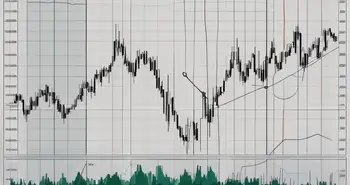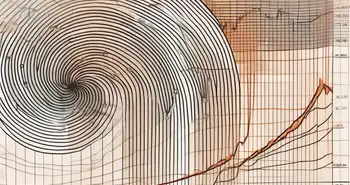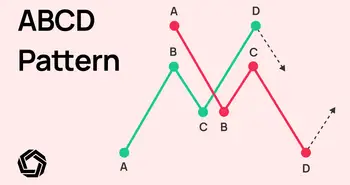How to Draw Fibonacci Retracement
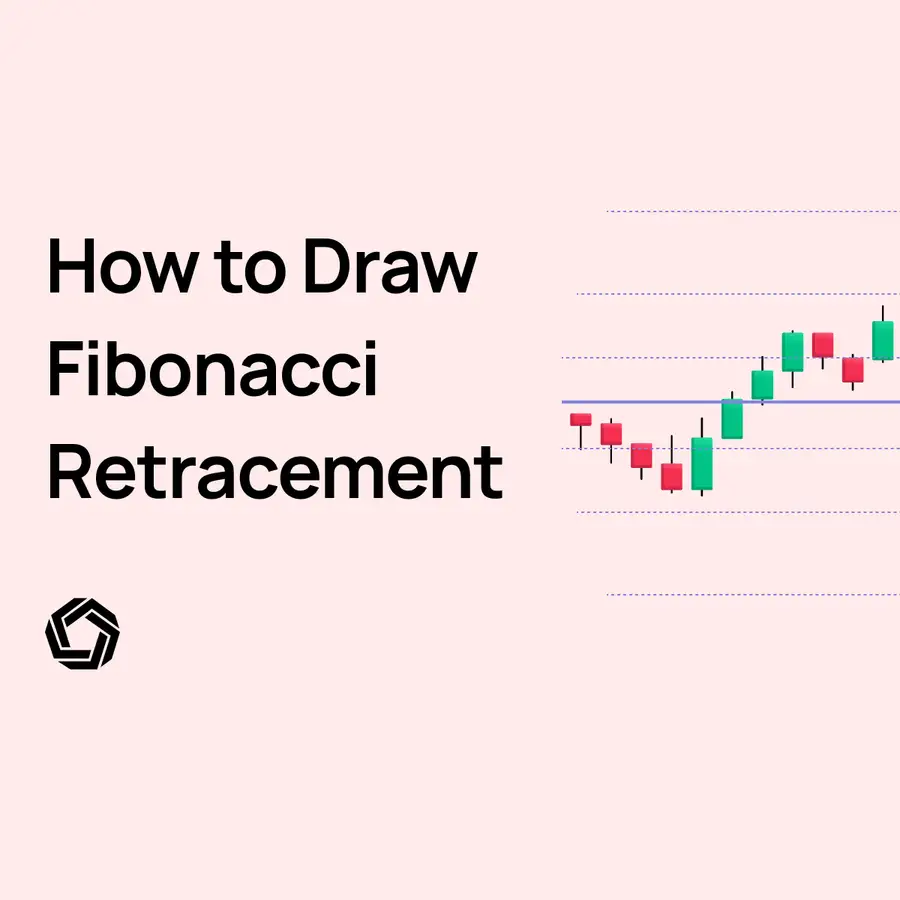
Fibonacci retracements are potent tools for technical analysis that can be used to determine potential support and resistance levels in an asset’s price action. These retracements are based on the Fibonacci sequence, a 13th-century mathematical pattern found in all types of applications, including financial markets.
This article is structured as a Fibonacci retracements tutorial. It describes key ratios, how to chart retracement levels, and how retracements work alongside other technical indicators. Whether you are a trading novice or a seasoned pro, this article will help you make more informed trading decisions.
Explanation of Fibonacci Retracement
Fibonacci retracement is based on the idea that prices tend to retrace or backtrack a predictable portion of pricing movements. And then, after this retrace, the price may continue to move in its original direction. Fibonacci ratios calculate levels that are drawn on a chart between a high and low point of a price movement.
Fibonacci Retracement and Technical Analysis
Traders can use the Fibonacci retracement to determine potential support and resistance levels in an asset’s price action chart. In terms of risk management, these levels can be used to make informed trading decisions, such as determining when to enter or exit a trade or when to set stop-loss orders.
By using Fibonacci retracements in combination with other technical indicators, traders gain a comprehensive understanding of market trends and make more informed trading decisions. Mastering Fibonacci retracements enables successful traders to maximize overall profitability.
Understanding the Fibonacci Sequence
Brief History of the Fibonacci Sequence
The Fibonacci sequence is an ordering of numbers wherein each number represents the sum of the two preceding numbers. The sequence starts from 0 and 1.
The sequence was first introduced in the 13th century by an Italian mathematician named Leonardo Fibonacci. It has since been applied in various fields, including such diverse fields as the arrangement of seeds in fruits, the design of buildings, music compositions, and also finance.
Reproduced below are the first computed numbers in the Fibonacci sequence:
0, 1, 1, 2, 3, 5, 8, 13, 21, 34, 55, 89, 144, …
To compute this sequence, start with the first two terms, 0 and 1, and then add them together to get the third term, which is 1. You then add the second to the third term to arrive at the fourth term: 2. This process is continued, adding the two preceding numbers to get the next sequential number.
Explanation of Fibonacci Ratios
In finance, the Fibonacci sequence is often used in technical analysis to identify potential levels of support and resistance in financial markets.
The most commonly used Fibonacci ratios are 38.2%, 50%, and 61.8%. These ratios are derived by dividing a number in the sequence by the number that follows it. For example, 55 divided by 89 is approximately 0.618, which represents the 61.8% Fibonacci ratio.
Significance of Fibonacci Ratios in Trading
The Fibonacci ratios are used to draw levels on a pricing chart between a high and low point of a particular price movement that is being studied. These levels are used to identify potential areas of support and resistance, which can help traders make more informed trading decisions.
By relying in part on these ratios and other technical indicators to make rational sound trading decisions, successful traders are able to keep their emotions and other trading biases in check.
For example, if a stock price retraces 38.2% of a particular price movement, it may find support at that level and bounce back up. If the stock price retraces 50%, it may find stronger support at that level and bounce back even higher. And if it retraces 61.8%, the stock price may indicate that the trend is reversing, and the stock price may continue to move in the opposite direction.
An example USDCAD candlestick chart visually depicting various Fibonacci retracement levels is provided below. If the USDCAD price retraces to one of these Fibonacci levels, traders often interpret this retracement as a potential entry or exit point.
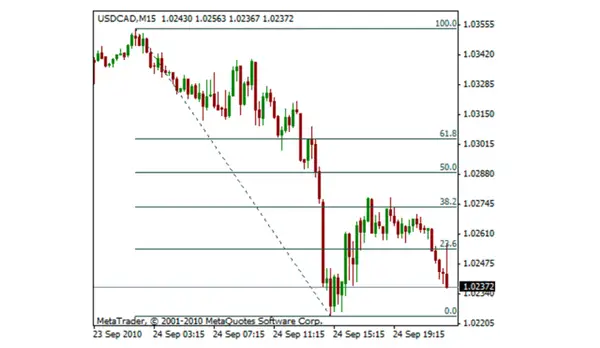
Fibonacci Retracement Levels (source: Wikipedia)
For example, at around 15:15 on September 24, USDCAD began to retrace or backtrack toward the 38.2% retracement level. However, USDCAD failed to break through this level so this level acted as a resistance level.
Traders may interpret this as a sell signal, as it suggests that USDCAD is likely to continue falling. And note this is what happened as USDAC moved well below the 23.6% retracement level.
What are Swing Highs and Swing Lows?
Swing highs and swing lows are important technical analysis concepts that help identify potential support and resistance areas. These highs and lows can be represented by candlestick patterns.
A swing high is a high point in the price of an asset where the price has recently been rising and is expected to stop before continuing to move upward. Conversely, a swing low is a low point in the price of an asset where the price has recently been falling and is expected to stop before continuing to move downward.
By identifying swing highs and swing lows, traders can draw trendlines to identify potential areas of support and resistance. For example, if the price of an asset has been trending upward and hits a swing high, a trader may consider selling the asset as it may provide an indication that the trend is reversing.
Conversely, if the price of an asset has been trending downward and hits a swing low, a trader may consider buying the asset as it may provide an indication that the trend is reversing.
Identifying Swing Highs and Swing Lows
Swing highs and swing lows can be identified by looking at a candlestick chart of an asset.
Specifically, to identify a swing high or swing low, concentrate on one candlestick and review the candlesticks residing on either side of your selected candlestick.
A swing high is established if the candlestick has a lower high on both the right and left sides.
A swing low is established if the candlestick has a higher low on both the right and left sides.
For example, in the candlestick chart provided below, the April 3 candlestick represents a swing low because both the April 2 candlestick (the candlestick on the left) and April 4 candlestick (the candlestick on the right) have a higher low than the low experienced on April 3.
Similarly, the April 14 candlestick represents a swing high because the April 13 candlestick and April 15 candlestick both have a lower high than the high experienced on April 14.
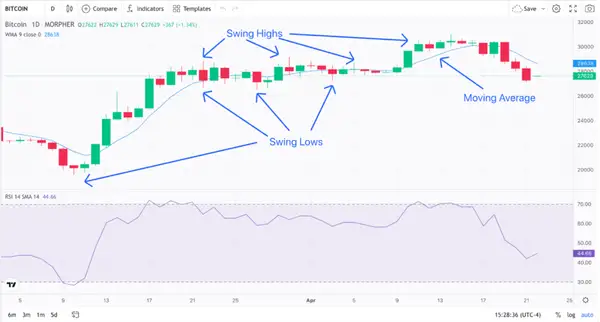
Swing Highs, Swing Lows, Moving Average, and RSI for Bitcoin 1-Day Chart (source: Morpher)
In practice, traders can use tools like trendlines or moving averages to help identify swing highs and swing lows more easily. Indicators like the Relative Strength Index (RSI) and the Moving Average (MA) can also be used to confirm swing point validity and to confirm the strength of a trend. Note that both the RSI and the MA confirm the validity of a number of swing points identified in the chart above.
Using Swing Highs and Swing Lows in Fibonacci Retracement
Swing highs and swing lows are oftentimes used along with Fibonacci retracement levels to identify potential areas of support and resistance.
For example, swing highs and swing lows are used to identify the initial high and low points needed to begin drawing Fibonacci retracement levels. By connecting the swing high and swing low with a Fibonacci retracement tool, traders can have levels drawn on the chart that represent potential areas of support and resistance.
If an asset has been trending upward and hits a swing high, a trader may draw Fibonacci retracement levels from the swing high to the swing low to identify potential areas of support if the stock price starts to retrace. As noted previously, the most commonly used Fibonacci retracement levels would be the 38.2%, 50%, and 61.8% levels.
If the stock price retraces to the 38.2% level, it may find support and bounce back up. If it retraces to the 50% level, it may find stronger support and bounce back even higher. And if it retraces to the 61.8% level, it may indicate that the trend is reversing, and the stock price may continue to move in the opposite direction.
Swing highs and swing lows can also be used to identify potential areas of resistance. For example, if a stock has been trending downward and hits a swing low, a trader may draw Fibonacci retracement levels from the swing low to the swing high to identify potential areas of resistance if the stock price starts to retrace. In this case, the 38.2%, 50%, and 61.8% levels would represent potential areas of resistance that the stock price may struggle to break through.
Drawing Fibonacci Retracement
Here are the steps for drawing Fibonacci retracements. This example will use a Bitcoin one-day price action candlestick chart.
First, in the Bitcoin price action chart produced below, the high and low points of the subject Bitcoin price movement are identified. The high point (BTC=$ 31,000) represents the top of the trend, while the low point (BTC=$ 19,500) represents the bottom of the trend. In this particular chart, the high is represented by a swing high, and the low is represented by a swing low.
Once these high and low points have been identified, a dotted line is drawn connecting these two points.
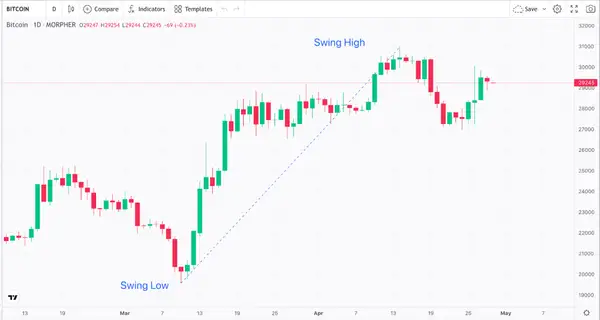
High and Low Points for Bitcoin 1-Day Chart (source: Morpher)
The next step is to draw the various Fibonacci retracement levels.
Using the Fibonacci ratios of 23.6%, 38.2%, 50%, and 61.8%, horizontal lines are drawn across the chart at these levels. As evident from the Bitcoin price action chart reproduced below, these levels represent potential areas of support and resistance.
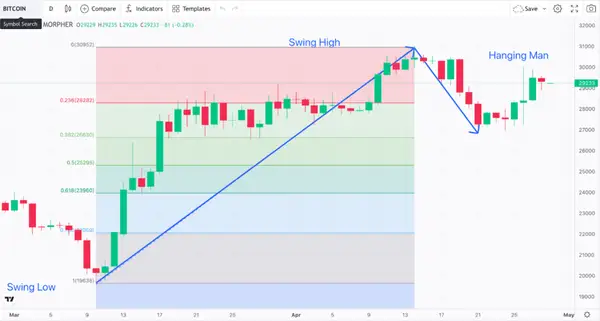
Fibonacci Retracement Levels for Bitcoin 1-Day Chart (source: Morpher)
Once the Fibonacci retracement levels have been drawn, Bitcoin’s price action can be analyzed to see if the Fibonacci levels are holding as areas of support or resistance.
If the Bitcoin price bounces off one of the retracement levels, it may indicate that the level is acting as support or resistance. For example, the falling Bitcoin price bounced off of the support level of 38.2%. It then later broke through the 23.6% level, indicating that this level was not a significant area of resistance.
Fibonacci retracement levels can be a useful tool on their own, but they are quite effective when used in conjunction with other technical analysis tools, such as trendlines, moving averages, or momentum indicators. These additional tools can help confirm the validity of the retracement levels and provide additional insight into potential areas of support and resistance.
For example, note that later Bitcoin price action experiences a bit of an uptrend but the formation of a Hanging Man denotes that the market may be finishing a reversal. Therefore, this presents a technical indicator of an exit point, where Bitcoin’s price may be preparing to start to move downward back towards the support level of 38.2%.
Tips for Trading with Fibonacci Retracement
Here are a few trading tips when implementing Fibonacci retracement:
- Identify clear trends and significant price movements to use as the basis for drawing Fibonacci retracement levels.
- Use multiple timeframes to confirm potential support and resistance levels.
- Combine Fibonacci retracement with other technical analysis tools for better confirmation.
- Use Fibonacci retracement levels in conjunction with other key levels, such as moving averages or trendlines.
- Set stop-loss orders below the Fibonacci retracement levels to limit potential losses.
- Understand that Fibonacci retracement levels are not the end all be all. Use them in conjunction with other analysis methods.
How to Use Fibonacci Retracement to Find Entry and Exit Points
Fibonacci retracements are used to identify potential entry and exit points. Here are some steps to use Fibonacci retracement to find entry and exit points.
In a bullish trend like the one Bitcoin price action illustrated below, a potential entry point could be at the 38.2% retracement level, which in this case, acted as a consistent level of support.
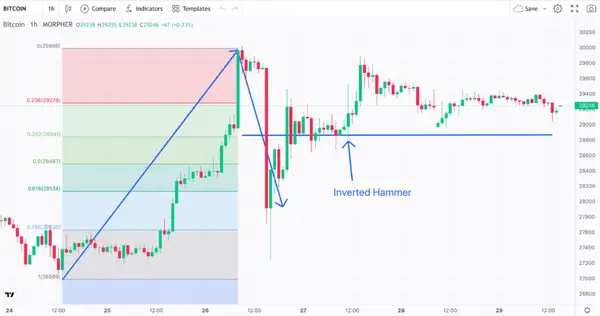
Fibonacci Retracement Levels for Bitcoin 1-Hour Chart (source: Morpher)
If Bitcoin’s price bounces off this level (which it has), it may indicate a continuation of the trend and provide an opportunity to enter an entry point for a long position.
And this entry point was confirmed by the appearance of an inverted hammer. A positive candlestick pattern evidences a bullish sign of things to come. Also, note that the Fib 0.382 level has maintained its position as a level of support.
In a bearish Bitcoin trend, as illustrated below, Bitcoin met resistance at the 61.8% retracement level, denoting a potential exit point. This potential exit point was confirmed by the existence of a Spinning Top. This candlestick pattern denotes indecision amongst buyers and sellers and, therefore, indecision about the future direction of Bitcoin’s price, hence its somewhat horizontal subsequent price movement.
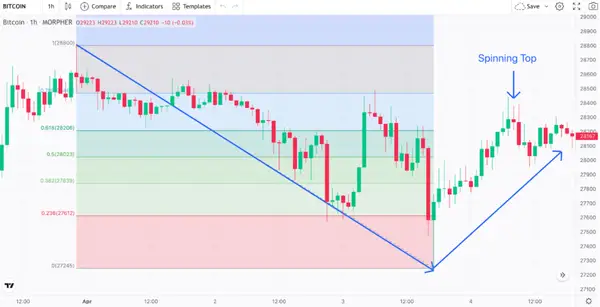
Fibonacci Retracement Levels for Bitcoin 1-Hour Chart (source: Morpher)
Combining Fibonacci Retracement with Other Technical Indicators
Traders can look for confluence between different analysis methods to combine Fibonacci retracement with other technical indicators.
For example, traders can look for Fibonacci retracement levels that coincide with key support or resistance levels identified by trendlines or moving averages. Traders can also use momentum indicators, such as the Relative Strength Index (RSI), to confirm potential entry or exit points identified by Fibonacci retracement levels. Combining different technical analysis tools enables traders to gain a more complete picture of the market, potentially increasing their chances of profitable trades.
Conclusion
Fibonacci retracement is a powerful tool that helps traders identify potential support and resistance levels. By using retracement levels in combination with other technical analysis tools, traders can make more informed trading decisions and potentially increase their chances of success. However, it is important to remember that Fibonacci retracement levels are not infallible and should be used with other analysis methods. With these considerations in mind, Fibonacci retracement can be valuable in any trader's toolkit.

Disclaimer: All investments involve risk, and the past performance of a security, industry, sector, market, financial product, trading strategy, or individual’s trading does not guarantee future results or returns. Investors are fully responsible for any investment decisions they make. Such decisions should be based solely on an evaluation of their financial circumstances, investment objectives, risk tolerance, and liquidity needs. This post does not constitute investment advice.

Painless trading for everyone
Hundreds of markets all in one place - Apple, Bitcoin, Gold, Watches, NFTs, Sneakers and so much more.

Painless trading for everyone
Hundreds of markets all in one place - Apple, Bitcoin, Gold, Watches, NFTs, Sneakers and so much more.


